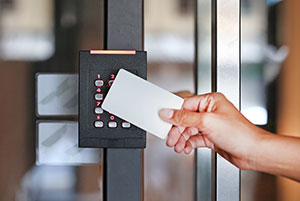As technology advances, it provides more ways of making our lives easier and more convenient – fortunately, this also applies to how we secure our homes and businesses.
First, there was the invention of security cameras and alarms, which increased security coverage while decreasing the need for human involvement, particularly security patrols. Then, as technology developed and became cheaper, it allowed manufacturers to offer high-quality products at prices that anyone could afford.
Now, we’ve reached the next evolution in security with intelligent video surveillance (IVS) systems. IVS systems take advanced security features that were initially only available for the biggest companies and put them within reach of all home and business owners.
This post explores the benefits of an IVS system and why you should consider getting one for your property.
What Is an IVS System?
Let’s kick things off by defining what IVS systems are and what they can do.
An Intelligent Video Surveillance (IVS) system is a security system that utilises advanced hardware and specialised software to record footage and/or trigger alarms, based on the user’s preferences. IVS systems achieve this through the use of analytics, which allow you to tell the system what to pay attention to – or give it specific criteria on when to capture images and video footage and when to sound alarms.
What Are the Key Features of An IVS System?
Common key features of IVS systems include:
- Advanced security hardware and software: an IVS system requires both high-end hardware, like cameras and sensors, and powerful image and video processing software to perform a large range of functions.
- High-definition picture quality: an IVS system’s top of the range hardware and software results in high-quality footage.
- Advanced image and video analytics: an IVS system’s software is capable of powerful and flexible analytics which detect suspicious activity within a scene through a variety of methods
- ‘Smart’ alarms: that are only triggered according to certain, pre-set, criteria.
- Remote access: an IVS system can give you access to live feeds from anywhere through a mobile device, like a smartphone or tablet.
- Advanced motion sensors: an IVS system’s motion tracking abilities means that it can be configured to only record footage or trigger an alarm when it senses movement. Motion sensors also make features like target tracking and people counting possible.
- Enhanced Search Capabilities: this enables you to scroll through footage faster than you could with traditional surveillance equipment, so you can get to the relevant parts with less effort.
What Are the Benefits of An IVS System?
Now we’re clear on what IVS systems are and what they can do, let’s explore their benefits in greater detail.
Deterrent
As with any security system, the mere presence of an IVS system can be enough to discourage potential intruders from breaking into your property. Criminals will see the security cameras and alarms and decide they’re better off trying their luck elsewhere.
High-Quality Surveillance
In the event someone decides to trespass on your property, intelligent video surveillance makes it far easier to determine what they’re doing. An IVS system’s analytic capabilities allow the system to detect unusual behaviour or if anything is out of place and, subsequently, trigger alarms to inform anyone that’s watching that an incident is potentially taking place. Not only does this mean that an IVS system is more likely to detect potential criminal activity, but it allows you to respond to it faster.
Easier To Solve Crimes
In the event a crime does take place, features offered by an IVS system, like face recognition and missing object recognition, can make it easier to solve. Plus, the HD footage common in IVS systems makes it easier to identify the culprits.
Less Need for Human Involvement
Features of an IVS system, like advanced motion detection and analytics, means it’s not crucial for someone to pay attention to a security feed 24/7. By the same token, in the event of a crime, IVS prevents the need to comb through hours of recorded footage. For both reasons, there’s less need for human involvement in surveillance activities and your security protocols will be less prone to human error.
Lower Insurance Premiums
As with any installing any security system, having an IVS system put in could make you eligible for a discount on insuring your home or business premises. This is because insurance companies look favourably on properties with security systems as they’re less likely to be broken into. Better still, if you actually need to make a claim, the high-definition images produced by IVS can make the process far smoother.
IVS Systems Vs Traditional Surveillance Systems
In this section, we compare IVS systems to traditional surveillance systems, detailing the pros and cons of each.
Pros And Cons of IVS Systems Vs Traditional Surveillance Systems
IVS Systems
Pros
- Increased Capabilities: because they utilise more advanced hardware and software, an IVS system has more functionality than a traditional surveillance system
- More Efficient: an IVS can store more footage than traditional surveillance and makes it easier to search through images and videos to find an incident. Plus, with the image quality being higher, it’s also easier to determine what’s going on.
- Fewer Man Hours Required: As an IVS system uses powerful software to analyse footage, there’s less need for human involvement. This cuts down on the number of man-hours required to secure a premises, as you won’t have to hire as many security guards – and not for as many hours.
Cons
- Higher Upfront Cost: because an IVS makes use of advanced cameras and sensors and sophisticated analytical software, it has a higher initial cost than a conventional security system
- Requires More Technical Know-How to Set Up Correctly: you need to be comfortable with surveillance equipment if you want to go down the DIY route with an IVS system, as they’re more complicated to set up than other surveillance systems. You’re far better off having an IVS system professionally installed which, naturally, adds to its cost.
Traditional Surveillance Systems
Pros
- Cheaper: a traditional surveillance system can be started small initially, if that’s what your budget dictates. If cost is a factor, you can start with a couple of cameras and sensors and grow from there.
- Simpler To Set Up and To Operate: because they could be comprised of simpler hardware and use software that doesn’t have too many features, traditional surveillance systems are typically easier to set up and operate than IVS systems.
- Good For Small Premises: traditional surveillance systems are still adequate for small homes and business premises
Cons
- Limited Capability: traditional surveillance systems will share some of an IVS system’s functionality, like motion detection, but they won’t have all of them and not to the same degree.
- Less Efficient: traditional surveillance systems can slow down the rate at which you’re able to analyse footage. Without features like advanced search, motion tracking, and object detection, you’re required to go through more footage and rely on your own observation and perception skills.
- More Reliance on Human Intervention: with traditional video surveillance, people are required to view the footage and to analyse what’s going on within a particular scene. However, a person is only able to concentrate for so long and can be distracted, tired, ill, etc.
What makes IVS the better choice?
An IVS system is the better choice for two main reasons: capabilities and speed. An IVS system has so many features that make it easier to determine what’s happening on your property and when an event demands your attention. Subsequently, you’re able to become aware of potential threats faster and have a much higher chance of preventing them from unfolding.
How Can an IVS System Help You?
Let’s take a more detailed look at some of the features of an IVS system and how they can be used to secure your home or business.
Applications of an IVS system
- Motion Detection
This is an analytic that can be set to trigger when an object moves through a scene. Motion detection can be set up to cover a portion of a scene or all of it and with varying levels of sensitivity. - Auto-Tracking
Similar to motion detection, auto-tracking follows people or vehicles through a scene, making it easier to identify things that appear out of place and could be potential threats Auto tracking could be applied manually or by user-defined parameters. - Intrusion Detection
Also known as a tripwire analytic, this is triggered when a person or object enters or leaves a user-defined area. It can be configured to sound an alarm, start recording, or transmit footage, depending on your preferences. - Face Detection
An analytic used to detect if a face has appeared in a video feed and if there is a person in the line of sight of a security camera. You can also configure an IVS system to take a snapshot if it detects a face. - People Counting
This feature counts the number of people in a defined scene and stores the figures for powerful reporting capabilities. This isn’t just helpful for surveillance as it can provide businesses with information that can help them increase sales and improve their customer service. - Heat Mapping
Heat Mapping highlights the areas and frequency of motion in a scene, through a graphical overlay. It uses red, yellow, and orange areas to indicate ‘hot spots’, while blue and green signify low movement areas. As well as being used to evaluate how busy an area is, heat mapping could also be used by a business to track customer movement to better understand their behaviour, provide a better service and, ultimately, increase your business’ profitability. - Abandoned or Missing Object Detection
This analytic is designed to detect when an object is removed from a specific area or has been abandoned within it. Once the area is set up, a time limit can be set to determine how long after an object is either placed in an area or removed that an alarm will trigger. This is ideal for high-value objects or areas at high risk for unwanted objects such as dumpsters. - Scene Change
This analytic detects any changes between the scene previously captured by the camera and the current one, which could include someone purposely obscuring the camera’s view. If it turns out the scenes are different, it will trigger an alarm.
Summary
With their high-definition cameras and advanced software, IVS systems make it easier than ever to determine what’s happening within your home or business at any time. Through its powerful analytics, you get to decide how to best secure your premises and come up with a tailored action plan for identifying and dealing with security threats.
If you’d like a free onsite inspection, to determine which kind of security system would best suit you, contact us and we’d be happy to advise you.




